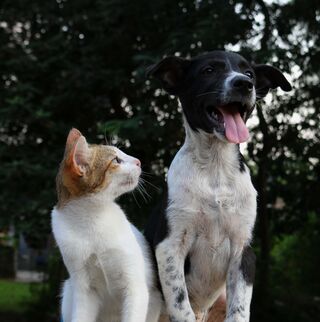Animal Behavior
Serving Up Truth Sandwiches About Dogs and Cats
How to counter misinformation about companion animal behavior.
Posted February 16, 2022 Reviewed by Ekua Hagan
Key points
- When trying to correct false information about dogs and cats, keep the focus on the truth.
- A truth sandwich puts the lie in the middle and gives most attention to the truth.
- Good pet welfare includes training with positive reinforcement and providing enrichment.

One of the frustrations of being either a pet guardian or a pet professional is that there are a lot of incorrect ideas out there about how to care for or train your pet. Some of them are downright dangerous and may result in a terrified dog or cat and/or in you getting bitten or scratched.
Although there’s an increasingly long list of reliable providers of good advice about pets, some of that incorrect info still persists. What are the best ways to counteract it?
Given the times we’re in, there’s been an increasing focus on how to report misinformation without accidentally spreading it further. These ideas are often about how to counteract information that is believed to be deliberately spread, lies that aim to manipulate. In the field of companion animal welfare, much of the misinformation is simply because people haven’t taken the trouble to learn more about the animals they are speaking of or continue to rely on out-of-date sources; it's not deliberately wrong and is often well-intentioned. But we can still use the same tactics to make sure we’re not accidentally spreading false information about dogs and cats.
What is a truth sandwich?
One approach, called the truth sandwich, was proposed by Berkeley Emeritus Professor George Lakoff. The idea is that you start with the truth, briefly mention the lie and debunk it, then go back to the truth again. What comes first and last is most likely to be remembered.
The truth is the bread and butter and the lie gets squashed in between.
It’s actually similar to the way we sometimes give medicine to pets: first a treat, then a treat with the pill hidden in it, followed quickly by another treat. (The difference being that the medicine is for the pet’s own good).
Maybe we can call it a treat packet. If we have to mention the misinformation, bury it in a pile of treats so that the treats come first and last and they are what gets the focus.
Examples of truth sandwiches about dogs and cats
So what might we say? Suppose we’re talking about training dogs.
- The truth: Training dogs with positive reinforcement is effective and it’s good for dogs’ welfare.
- The lie, reframed: It’s not true that you need to boss your dog around to make them behave.
- The truth again: Dogs respond really well to positive reinforcement training in which you give them a treat when they do the behavior you like. And it helps to build your bond with your dog.
And here’s another example, this time about cats:
- The truth: Enrichment is good for cats and interactive play with a wand toy is a great way to provide it.
- The lie, reframed: Despite the stereotype, cats aren’t actually loners who will always occupy themselves.
- The truth again: Making more time to engage your cat in interactive play is linked to more positive behaviors in the cat. It’s good for their welfare and fun for you too.
Another analogy for this relates to the way we work with pet guardians. We teach people that instead of thinking about the behaviors that are causing them issues, they should think about the behaviors they would like to see instead and then train those.
It’s very easy to get caught up in the negatives and to want to spend time picking apart the falsehoods. We all do it; no one is immune. But thinking about a truth sandwich helps us ensure that the important bits of info get the important slots—first and last—and that the filling of the sandwich is very bland and much less interesting.
It’s also a good opportunity to think about what we really want for our pets, or for our clients’ pets. What are the aspects that matter most to us? For me, the most important truth is that our aim should be to make our pets happy. They rely on us for everything in their lives and so that role falls on us.
So what’s this truth sandwich?
- The truth: We should aim to make our pets happy. When we meet their needs and make them happy, they are less likely to have behavior issues and will have a better relationship with us.
- The false filling, reframed: It’s not about making them be obedient or subservient (dogs) or just leaving them to their own devices (cats).
- The truth: When our pets are happier, we’re happier too.
Don't forget the evidence
Of course it's important to provide evidence to back up those claims. If you want to learn more about why positive reinforcement is the best way to train dogs, Ziv’s (2017) review is a great place to start. And the importance of play for cats is discussed in Strickler and Shull’s (2014) or Windschnurer et al (2022). My books, Wag: The Science of Making Your Dog Happy and the forthcoming Purr: The Science of Making Your Cat Happy, explore how to make pet dogs and cats happier.
References
Strickler, B., & Shull, E. (2014). An owner survey of toys, activities, and behavior problems in indoor cats. Journal of Veterinary Behavior: Clinical Applications and Research, 9 (5), 207-214 https://doi.org/10.1016/j.jveb.2014.06.005
Todd, Z. (2022) Purr: The Science of Making Your Cat Happy. Greystone Books.
Todd, Z. (2020) Wag: The Science of Making Your Dog Happy. Greystone Books
Windschnurer, I., Häusler, A., Waiblinger, S., & Coleman, G. J. (2022). Relationships between owner and household characteristics and enrichment and cat behaviour. Applied Animal Behaviour Science, 105562. https://doi.org/10.1016/j.applanim.2022.105562
Ziv, G. (2017) The effects of using aversive training methods in dogs – a review. Journal of Veterinary Behavior, 19:50-60 https://doi.org/10.1016/j.jveb.2017.02.004




